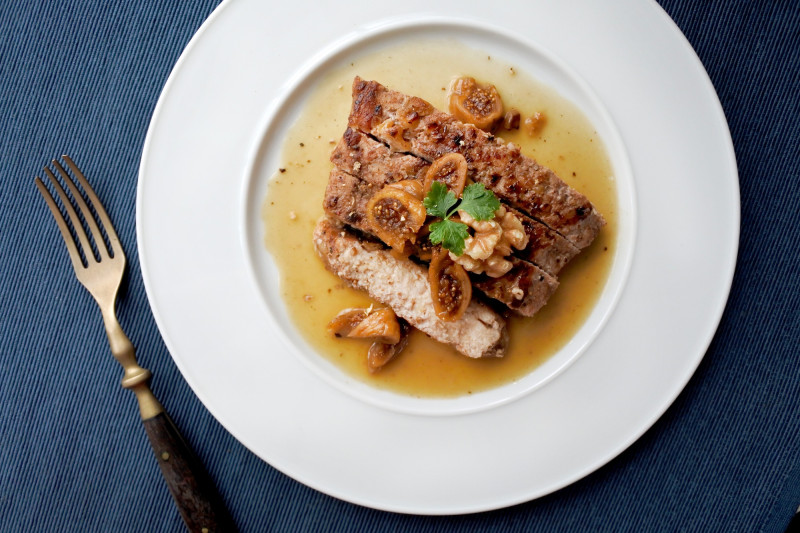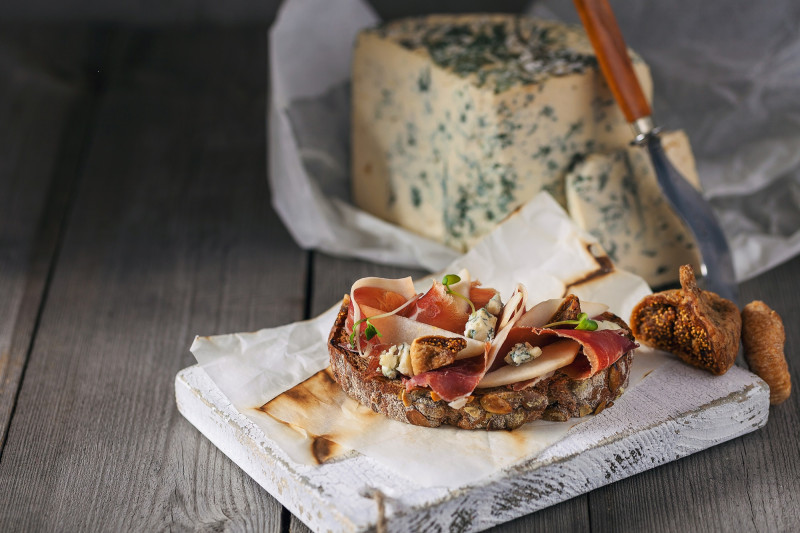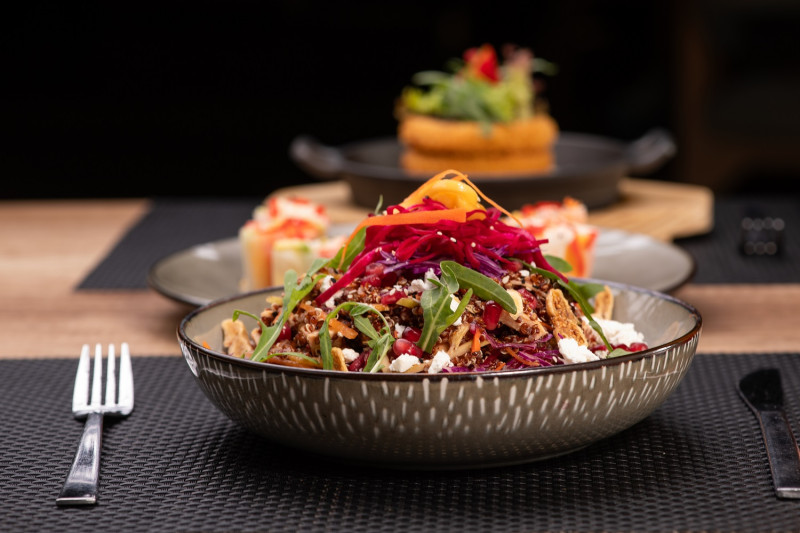The royal white fig of Evia has its due and is re-entering our kitchens. Eleni Psychouli guides us…
On the east coast of Evia, Kymi, hometown of gynecologist George Papanikolaou, it was once a rich port. In the 19th century, Kymi shipowners transport from here to France and the Black Sea the famous black wine of the region from the local variety Mavrokountoura, in Kymi money flows abundantly, but also culture and modern concepts. Near the eastern coast of Evia and 80 kilometers away from Chalkida, the city had its own artificial harbor and its own fleet.
Unfortunately, the local captains failed to modernize their fleet, phylloxera destroyed the vines and the old glory was now only a memory. But Kymi was always fertile and fertile. And local production, from the beginning of the last century, turned to the fig, which, moreover, has always had an organic relationship with the place. Little by little, they began to plant more figs in the olive groves, until the fig became king, eliminating the leopards. The fig tree is a hard nut, it doesn’t need a lot in its cultivation, which can easily become organic.
22 villages with PDO royal white fig
In a beautiful, green area between the mountain and the sea, they spread out 22 villages producing PDO, since 1993, royal white fig of the regionthe one that stands out for its thin skin, almost yellow color, soft texture and wonderful aroma. The characteristic of this all-sweet fig is its thin skin. So thin, that it is difficult to transport to the fresh fruit markets, with the risk of tearing and disintegrating.
Every end of summer and for a month, the harvest fever begins, which must be done quickly, in order to catch the last rays of the sun in the “sunshine” of drying, which will give the aroma of the sun to the dry fig, but also to catch the rain, which is his worst enemy. The rain and heat are not helping the fig. The rich fruit needs the right soil and the August sun that will cook its deliciousness. No one can say for sure when the Kymi variety appeared, but the microclimate of the area prevents the waxworm, the fig’s biggest enemy, from growing, so no fertilizers are needed.
Valuable since Greek antiquity, the fig still divides world etymology, which has yet to decide what exactly the ancient slanderer was. Of the 5 different versions, let’s keep the one that wants him to stick his nose in other people’s business. Be that as it may, our ancestors loved the fig both for the economic and for the its nutritional value: deliciousness but also vitamins, minerals, phenols, calcium, potassium, zinc, manganese and lots and lots of dietary fiber. The fig, therefore, in ancient times, it came to us from Egypt. Our ancestors, who classified it among the sacred plants, knew its miraculous nutritional value but also its fragile, sensitive nature. To preserve it, they learned to dry it in the sun. The fig was not missing from the daily table of antiquity, it was included in the diet of athletes and in the diet of those preparing for the Olympic Games, soldiers took it with them on campaigns.
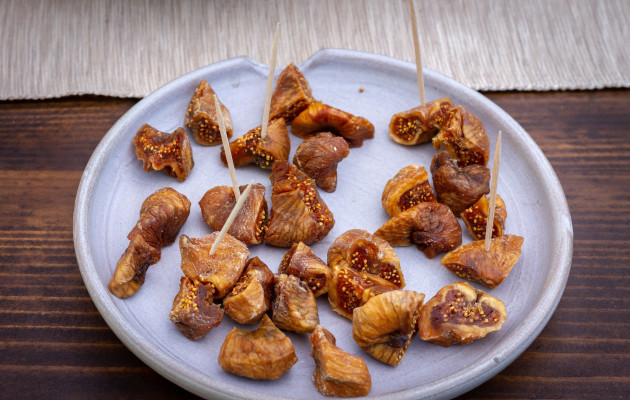

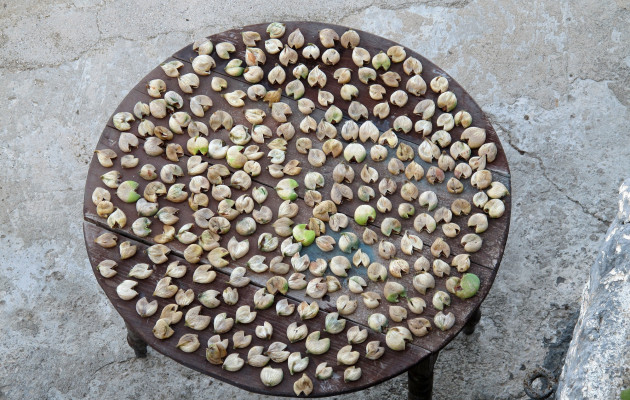
Its drying method
Among the first products that effortlessly won PDO certification in our country, the Koumiot fig has its own uniqueness: nowhere in the world is it dried the way it is done here. A handmade and completely traditional process, he splits the figs in half and then, finding the matching one, fits them together, creating the famous ascadas. In this way, the fig remains juicy and soft even after drying. The action of the wind and the sun complements the labor of the people. The harvest starts in the summer and ends in September. From the middle of August, the whole area is dressed in the golden color of a huge outdoor “sunshine”. When the weather also helps, as the fig is extremely sensitive, the production increases year after year, About 3500 tons are exported every year in Europe, America, Canada and Australia or where there are mainly Greeks, however the largest quantity is traded in the Greek market.
After the harvest, it comes the screening: by eye and hand, only the “mustelia”, the overripe figs, are selected, which are split, placed in wooden crates and dried under the August sun for 3-4 days. Then, the “askades”, “ischades” in ancient Greek, are made, which are left in the sun for another two days and then boiled to sterilize them. This is followed by final drying. No sulfur vapors are used in the whole process and the only thing that is allowed is the bay leaf that will protect the fig from the devils who will crave it, as the most natural, primal preservative. However, there is also the process of smoking in sulfur vapors, for those who want to maintain a white, appetizing color in their production. Sulfurization is a natural process, which also makes the fig more resistant, protecting it from insects and germs. It is said that a Cypriot merchant first brought the process, perhaps a holdover from the English, who borrowed this method from the Indians.
Each fig goes through 34 hands. Machines could never replace the hands of women who learn the process from the moment they start walking. Only these can understand, from experience and from instinct, when a fig is good or when it has started to turn sour, only they know how to feel the balance of the askada.
How we use it in the kitchen
Local housewives put the fig on pecan piethey make wine from a fig, they put it in chicken stuffing, on truffles and at chocolatesthey make with fig sauces for the chicken or saganaki. And it is a Dionysian joy to succeed in making honey when the whole village gathers in the courtyard to make the precious liquid, full of concentrated nutritional value, natural sugars and rich in antioxidants. The pan keeps coming out pancakes for the treats, which will be poured with the fresh honeydewfeasts and songs are set up to celebrate another harvest. The last sunny days of the fig tree can be tiring but they are also a celebration. A celebration that since ancient times was associated with the worship of Dionysus and Demeter. An annual cycle closes with wishes for a good harvest “next year too”. From this month, the income of the whole year for each family is judged.
In Kymi the fig flourished until shortly before the second world war. Then the people preferred life in the cities, until the last financial crisis has brought back many young growers and entrepreneurs who gave a new breath to the processing and packaging aesthetics as well as fresh ideas in its cooking.
sycopasta, healthy bars, jams with fresh or dried fig, chutney, pastelretzel, petimezi or sykomelo, which goes well with sweets but also with all sauces and vinaigrettes. The old forgotten recipes of the grandmothers create new, innovative products that have been loved by the chefs of the new creative cuisine and also by us, the inhabitants of the city, who until recently only knew the fig as dried. In the olden days, the dried fig was the star of winter evenings, when the family gathered around the fireplace or stove. Afterwards, its consumption faded a bit, as the new Greeks of the city forgot the fireplace and the stove, along with the culinary habits of the village. But the new era dawns hopefully. In the modern vegan or healthy diet, the fig has regained its lost value and really, it is so convenient that it fits everywhere: in breakfast oats and yogurt, in smoothies and juices, in compotes with dried fruits, in chutneys and sauces for meat or chicken, sweet or savory Tarts with Roquefort, it fits perfectly on a plate with cheeses and charcuterie, it goes into cakes and puddings, even in an alternative baklava, it also becomes a dessert of the spoon.
Pork fillet with figs and orange
Materials for 4 people
2 whole pork brisket fillets
juice and zest of 2 large oranges
1 cinnamon stick
1 glass of sweet wine (Samiotic type)
4 tbsp olive oil
1 tbsp oregano
1 tbsp spice mix for meat or chicken
salt and pepper
6 dried figs, cut into quarters
Procedure
In a taper, put the salted brisket and cover it with all the other ingredients. We leave it from the previous one to marinate in the refrigerator. If we still don’t have time to marinate it, it doesn’t matter.
Transfer our ingredients to the pan, cover with the lid and bake at 220 degrees, in a hot oven for about 30 minutes. We are very careful during grilling so that the brisket does not dry out. Its center should remain pink. While the meat is cooking, pour the sauce over it.
Serve it with mashed potatoes or boiled potatoes.
*We can replace dried figs with fresh ones when they are in season.
*In the same way we can bake chicken wings or legs.
*If we find fresh oregano, spread its sprigs on the bottom of the pan and place the fillets on top.
Salad with cabbage and dried figs
Materials
½ red cabbage
¼ of a white cabbage
3 carrots
5-6 sprigs of chopped parsley
1/3 fl. blonde raisins
½ cup coarsely chopped walnuts
3 dried figs, chopped
A little anthotyro or katiki
For the sos
½ cup olive oil
1 tbsp dry coriander crushed in a mortar
1 tbsp soy sauce
1 tbsp mustard
juice of 1 lemon
juice of ½ orange
zest of 1 orange
salt and pepper
Procedure
Grind the cabbage and carrot in the food processor.
In a bowl, mix with the parsley, raisins, walnuts and figs.
We salt.
Whisk all the sauce ingredients in a bowl.
Mix the sauce with the vegetables well.
Garnish with a few rocket leaves and pomegranate seeds.
Secrets:
* The salad becomes tastier if it is marinated for ½ hour in the refrigerator, covered with cling film. Even better, you can make it from the previous one and add the nuts at the end.
*The secret of this salad is to grate the vegetables very, very finely in the food processor or on the fine grater of the onion.
Source: Skai
I have worked as a journalist for over 10 years, and my work has been featured on many different news websites. I am also an author, and my work has been published in several books. I specialize in opinion writing, and I often write about current events and controversial topics. I am a very well-rounded writer, and I have a lot of experience in different areas of journalism. I am a very hard worker, and I am always willing to put in the extra effort to get the job done.


